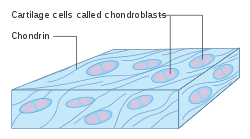Chondroblasts
| Chondroblast | |
|---|---|

Diagram of cartilage cells called chondroblasts.
|
|
| Details | |
| Identifiers | |
| Latin | chondroblastus |
| Code | TH H2.00.03.5.00002 |
|
Anatomical terminology
[]
|
|
Chondroblasts, or perichondrial cells, is the name given to mesenchymal progenitor cells in situ which, from endochondral ossification, will form chondrocytes in the growing cartilage matrix. Another name for them is subchondral cortico-spongious progenitors. They have euchromatic nuclei and stain by basic dyes. These cells are extremely important in Chondrogenesis due to their role in forming both the Chondrocytes and cartilage matrix which will eventually form cartilage. Use of the term is technically inaccurate since mesenchymal progenitors can also technically differentiate into osteoblasts or fat. Chondroblasts are called Chondrocytes when they embed themselves in the cartilage matrix, consisting of proteoglycan and collagen fibers, until they lie in the matrix lacunae. Once they embed themselves into the cartilage matrix, they grow the cartilage matrix by growing more cartilage extracellular matrix rather than by dividing further.
As suggested in the name, mesenchymal progenitors originate from the mesoderm. These cells, when forming from the mesoderm, specifically form from embryonic stem cells via induction through BMP4 and fibroblast growth factor FGF2 while the fetus is inside the womb. It has been suggested that differentiating embryonic stem cells with these growth factors could prevent stem cells, once injected into potential patients, from forming teratomas, or stem cell caused tumors.
...
Wikipedia
